RECOIL OFFGRID Preparation Staying Frosty: Winter Ready AR
In This Article
Have recent weather events across the United States, and across the world, given you pause to contemplate preparedness? If you are like me, and find yourself constantly asking what if, then perhaps the idea of firearms operation in winter environments, or making a winter ready AR, has become a source of concern. This is certainly not a new topic.
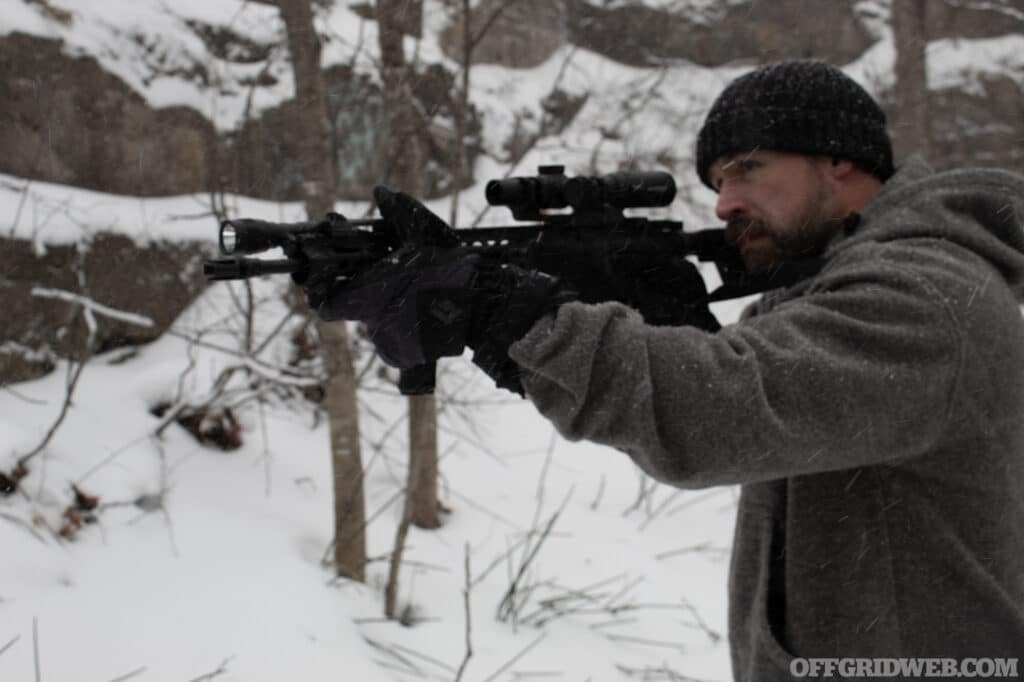
Above: Simple tasks, such as aiming, become more difficult when wearing bulky winter clothing.
On the contrary, as long as firearms have been available, they have been used successfully in cold conditions. However, there are some major differences between filling a muzzleloader with a colonial powder horn, and cycling through a malfunction on 21st century AR.
After scouring through a multitude of online sources regarding operating an AR in the winter, and spending hours outside at a snow-covered range, I have collected a few key takeaways that may come in handy the next time you encounter a tactical or self-defense situation when the flakes are flying.

When the mercury drops, the first thing most sane people do before they venture into the cold, is cover exposed skin with bulky, insulative apparel. The more cold it gets, the more layers get added. This excess clothing bulk is the first friction point a cold weather AR user will encounter.
Hunters who spend time in higher elevations or in northern latitudes, typically find a suitable location to hunker down, get set up, and train their firearms where they believe a target will present itself. This extra time makes it easier for a cold-weather hunter to position the buttstock in a way that compensates for added clothing.
Unfortunately, in a tactical or defensive situation, this extra prep time will most likely not exist. Extra attention must be given to the way bulky winter gear changes the way an AR is slung and shouldered. It may mean giving the sling extra slack, or making shouldering movements more exaggerated so the firearm clears the extra girth of additional clothing.
Reducing bulkiness to the optimal level is an art in itself. In many cases, bulk can be reduced by investing in what is known in snow-sports as technical clothing. These are garments with synthetic or modern wool fibers that have been weaved and coated in such a way so as to minimize the risk of penetration from the elements, maximize heat retention, and afford greater maneuverability.
The layers of technical clothing can be added to or taken away depending on the level of activity. For still hunting, more layers at the expense of extra bulkiness will be preferred. But for activity that is physically intense, like trudging long distances through the snow, layers can be reduced to the point where it feels like nothing but a spring jacket is being worn.
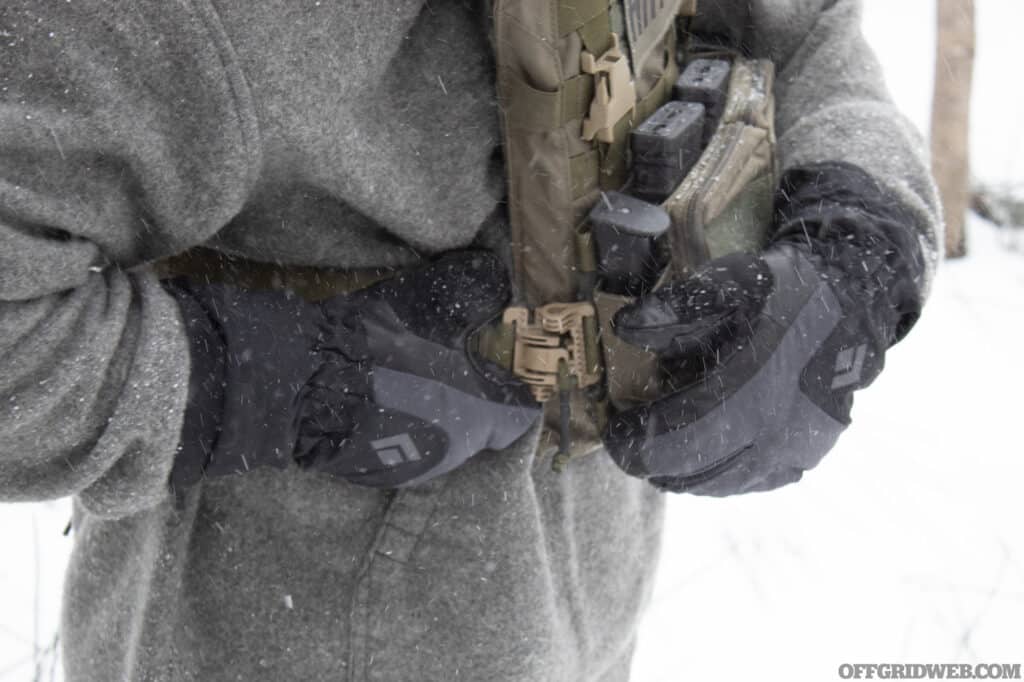
Above: Manipulating small items, or trying to grab magazines can feel clumsy and awkward when wearing thick gloves. Adding things like paracord straps or rubber grips will aid in these endeavors.
Gloves, hats, boots and face masks have all experienced similar modernization and it is well worth upgrading those decades old items to something more efficient. Getting the right combination takes a little experimentation, but once it's dialed in, going out in the cold no longer seems formidable.
It seems like an overly simplistic step, but having modern cold weather clothing can drastically reduce the amount of added bulk that needs to be dealt with. As the old saying goes, “there is no bad weather, only unsuitable clothing.”
Other than polymer grips and buttstocks, the AR is metal, which means it quickly mirrors the ambient temperature. Thin gloves will be a one-way ticket to frostbite, and no gloves could lead to contact freezing when bare skin contacts the hand guard or receiver. Thick gloves or finger mitts are a must, especially if the situation demands an extended time outside.
An ideal pair of winter gloves will have a thin liner, and an outer shell component This will keep your fingers toasty, but it will make manipulating the functioning elements of an AR a real challenge unless a few modifications are made to the platform.
Probably one of the most important modifications to an AR adapted to the cold, should be to widen the trigger guard. For a bare hand, or shooting gloves, the stock trigger guard is just fine. But try adding an extra inch of padded diameter to your trigger finger. Many people experience how gloves can get in the way of simple activities without even giving it a second thought.
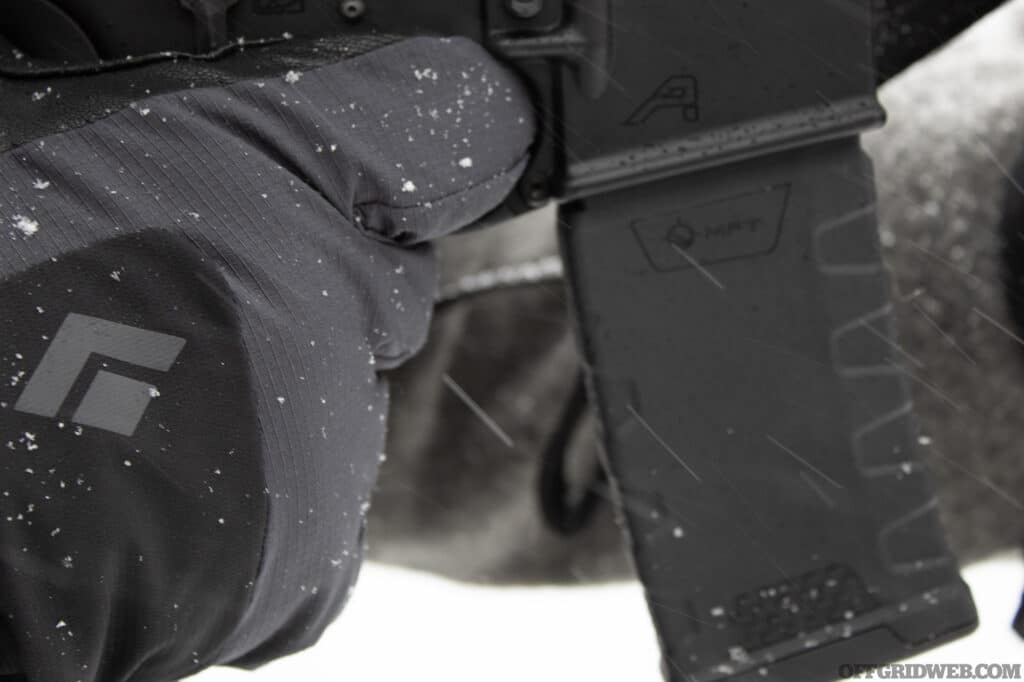
Above: Taking your gloves off when temperatures are below freezing can cause bare skin to freeze to metal. Even “shooters gloves” can lead to cold injuries due to their lack of insulation.
Just put gloves on and try getting house keys out of a pocket while holding a grocery bag. A pocket that fits an ungloved hand with room to spare, suddenly becomes a warded lock and the source of much irritation. Before long, there is a glove being held between teeth, while one hand is blindly fumbling for the right key to use.
It's not an identical scenario to firing an AR, but it highlights the convenience of having extra room to access the trigger. Without this extra wiggle room, it becomes a recipe for negligent discharges, or preventing the shooter from being able to fire at all.
Firing the weapon is important, but other functions can be adapted for cold environments as well. When fingers are covered with extra padding, their dexterity is greatly reduced. Instead of the charging handle meeting the stiff resistance of skin tissue, it is met with the soft give of insulated fabric. Maybe you will assert enough pressure to compensate for this and chamber a round.
Or maybe the glove will slip, costing extra time that you may not have. Either way, why take an unnecessary chance? Things like the bolt lock, charging handle, safety and magazine release can be replaced with inexpensive upgrades that offer larger access points for gloved hands. These simple changes will make operation and manipulation much easier while still being able to keep your fingers and hands safe from cold weather injuries.
There is a lot of conjecture about lube and its functionality in cold conditions. Thankfully, a lot of progress has been made over the past century in synthetic petroleum products. One of the most common gun lubricants available, CLP, can be used in temperatures ranging from -60° to 160°F. Many gun lubricants operate well within this temperature range, and it is difficult to find a better substitute.
Operating an AR at the coldest end of the spectrum, may result in the lube becoming more viscous, but unless you are located in Antarctica, Greenland or Siberia, it should not be too much of a concern.
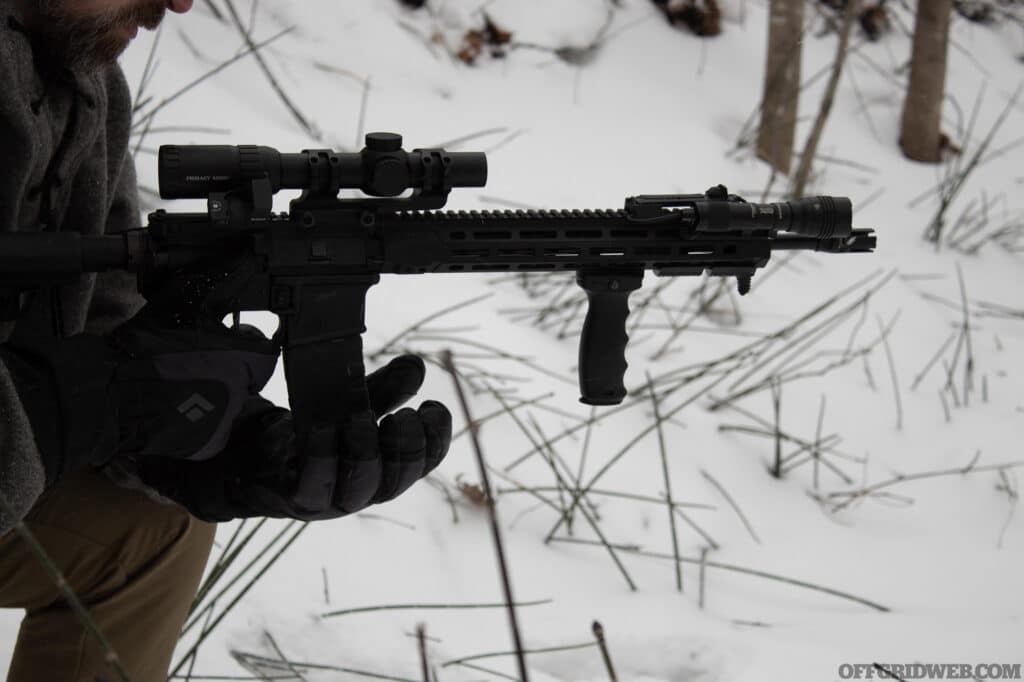
Above: Utilizing magazines made from composite materials instead of the old-school aluminum mags, will prevent them from sticking due to condensation.
There is a lot of back and forth about using dry graphite lubricants in cold weather, which may work for some firearms, but it should be avoided with the AR due to the composition of its upper receiver. Turns out that graphite has a corrosive effect on aluminum if a little moisture is added. Which means if you are using graphite lube in the cold, and you fire a few rounds, the condensation created from the heat will create damage to the inside of the AR’s receiver.
A handy item to have in the cold is a cloth soaked in silicon spray, kept in a plastic bag, and stored in an inside pocket next to your body to keep it warm. This can be any silicone based lube, including the ultimate remedy for any stuck metal, WD-40. If the lube on the AR starts to get gummy because of the cold, or some mechanism seems to be sticking, the residual silicone on the cloth can be wiped on it to get it back up and running smoothly again.
As snow accumulates, it creates potential hazards. Anyone who has wandered too close to a snow-laden tree may have succumbed to the startling, and aptly named tree well. Tree wells occur when tree boughs capture large quantities of snow, while snow accumulates around the outer perimeter of the boughs. This creates a deep and hidden cavity that the unaware could fall into and become trapped.
They are more prevalent near evergreen trees. Snow piled up on the boughs can also drop to the ground due to wind, radiant heat from the sun, or bumping into them by accident.
Drifting occurs when the strong wind blows snow, piling it into powdery waves, concealing tripping and slipping hazards. Drifts conceal the topography of the land, making it difficult to determine the depth of the snow at any given point. When walking through an unknown area that has been drifted over, becoming mired in a snow depression could be a costly mistake.
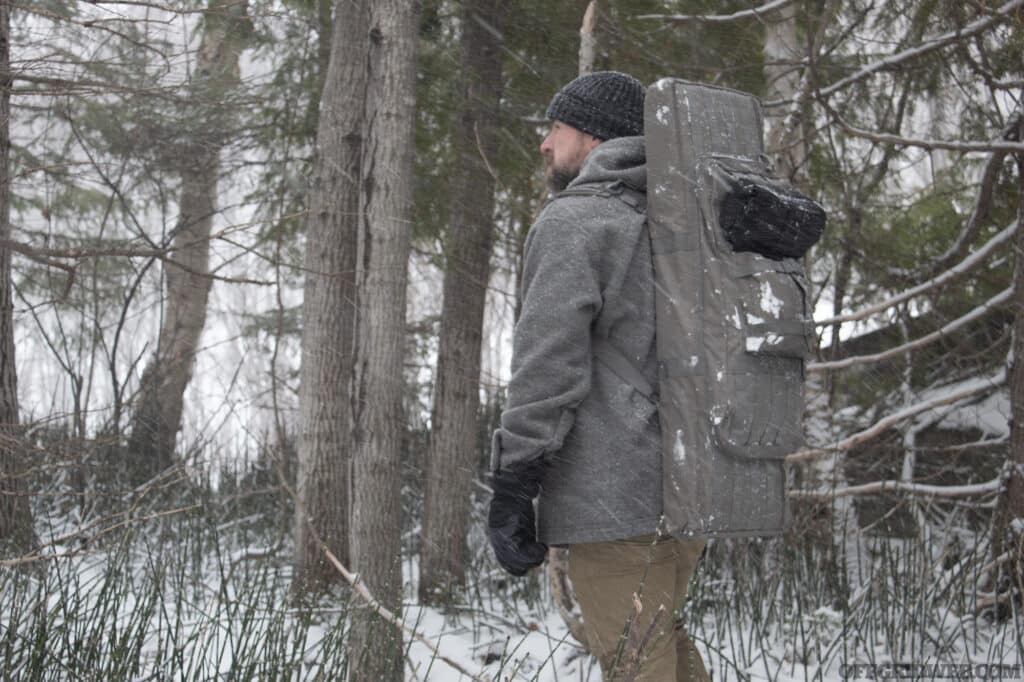
Above: Moving with a firearm can present challenges in the best of conditions. Moving with a firearm in thick snow can be potentially fatal.
They may be fun to bust through with a car, or throw your neighbor’s misbehaving child into, but snow drifts may present an underestimated risk in a tactical situation.
Moving with an unprotected AR barrel through these obstacles will most likely result in frozen flakes or ice particles getting inside the barrel, maybe even plugging it. The last thing anyone needs is a critical barrel malfunction when firing.
There are a variety of barrel covers and plugs that will easily prevent this, but even a simple layer of electric tape will do the trick in a pinch. It is crucial that, when traveling through the snow, extra caution and increased muzzle awareness be practiced.
Keeping an AR lightly lubed and modified for easier access will keep it firing well for sentient snowmen. But for those of us who may have to come back inside, or transition from warm to cold or vice versa, there are a few additional measures that are worth taking. Moisture from breath, smoke, or making quick temperature transitions will cause the lenses from optics to fog up.
A simple step to mitigate this is to apply your favorite anti-fog product to the glass, ensuring a safe and effective aim.
Breath can fog an optic, but it can also stop your AR from firing in a bad way. Breathing in freezing air causes the sensitive lining of your nose and lungs to become irritated. To prevent this, your body will start secreting more mucus, the reason why freezing temps seem to make your nose run constantly.
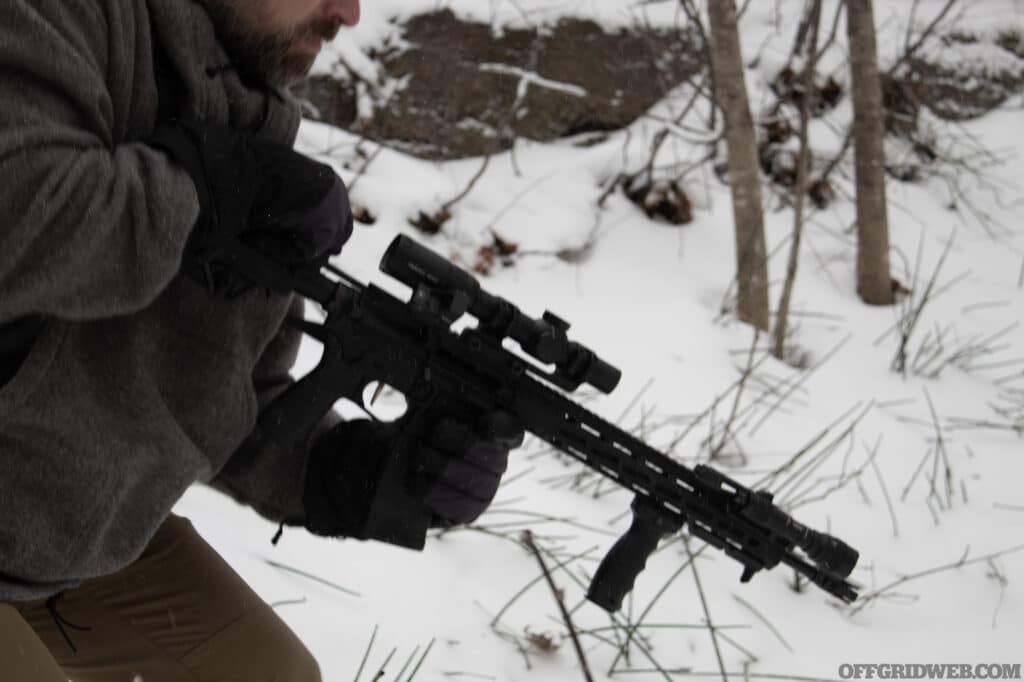
Above: Smaller components used to manipulate the function of an AR should be replaced with larger versions.
This biological feature to prevent damage to your airways, could become a serious problem if you are not paying attention to where your nose is dripping. Be aware of where your AR is slung. If it is in the path of a drippy nose or beard stalactite, the mucus could be collecting and freezing, causing components to seize until they have been thawed out.
Many optics these days, especially popular red dots, have batteries. As the temperature drops, chemical reactions taking place within a battery slow down, producing less current. After becoming cold enough, there is no longer enough energy produced to power the device. One technique is to wear a tactical harness with an admin pouch close to your body, underneath your technical clothing layers.
The heat from your core will keep anything stored in the admin pouch warm, including extra batteries. Although there is not a great way to mitigate frozen batteries, it pays to be cognizant that, if there is a powered optic or light on your AR platform, your operating window to use those devices is limited in cold weather.
A common adage in military circles is to train how you fight, and nothing will prepare you more for AR use in cold weather, than to go out in cold weather and practice operating it. It is easy to watch videos, read articles, and become lulled into a false sense of security by thinking this has made you prepared. Avoid this common mistake by being proactive, and going through the motions in as realistic of a setting as possible.
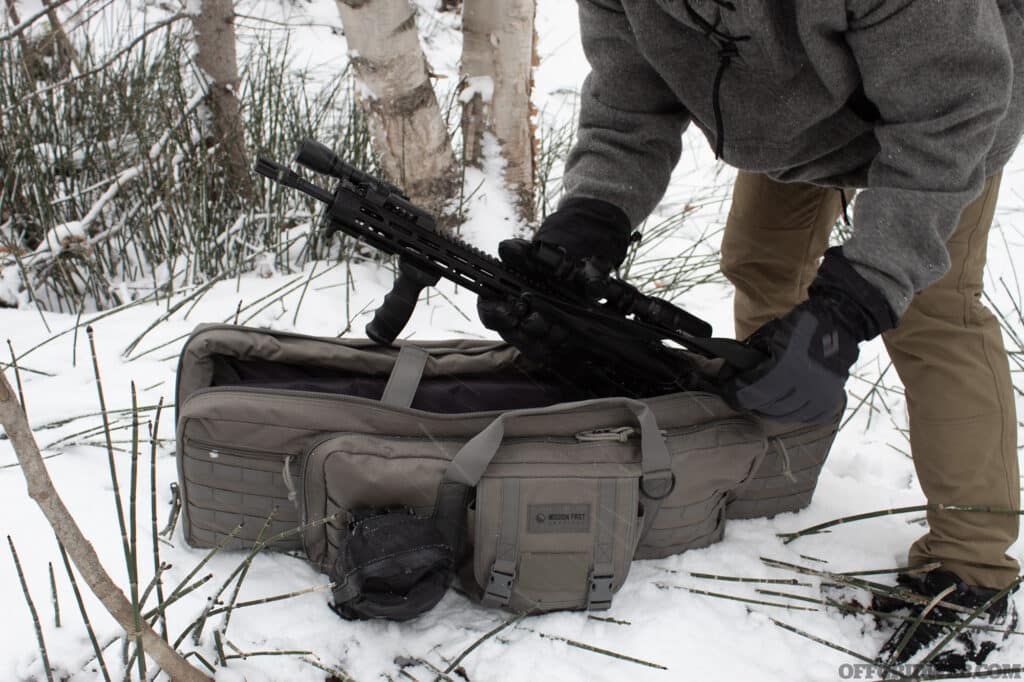
Above: Training with your gear in realistic conditions is the only way to know for sure what needs to be altered, replaced, or removed.
Even if there are no nearby outdoor ranges open in the winter, simply going outside wearing all of your winter gear and physically going through motions will give you a much better understanding. Start with it unloaded, or with dummy rounds, and practice shouldering, aiming, loading/unloading, swapping mags, charging, and correcting malfunctions.
By going through the motions, it will become quickly apparent where changes need to be made, and how to operate the AR more effectively. No two biomes are the same, even across relatively short distances, and the only way to find out what works in yours is to get out there and rehearse.
Subscribe to Recoil Offgrid's free newsletter for more content like this.
 STAY SAFE: Download a Free copy of the OFFGRID Outbreak Issue
STAY SAFE: Download a Free copy of the OFFGRID Outbreak Issue
No Comments